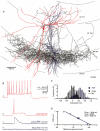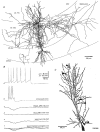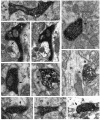Unitary IPSPs evoked by interneurons at the stratum radiatum-stratum lacunosum-moleculare border in the CA1 area of the rat hippocampus in vitro
- PMID: 9503336
- PMCID: PMC2230758
- DOI: 10.1111/j.1469-7793.1998.755bv.x
Unitary IPSPs evoked by interneurons at the stratum radiatum-stratum lacunosum-moleculare border in the CA1 area of the rat hippocampus in vitro
Abstract
1. Hippocampal non-principal neurons at the stratum radiatum-stratum lacunosum-moleculare border (R-LM interneurons) of the CA1 area may constitute several cell classes and have been implicated in the generation of GABAergic unitary IPSPs. Using biocytin-filled electrodes we recorded R-LM interneurons intracellularly in vitro and determined their postsynaptic effects in concomitantly recorded pyramidal cells. 2. Light microscopic analysis revealed four populations of R-LM interneurons with distinct axons: (1) basket cells (n = 4) with axons predominantly ramifying in the pyramidal cell layer; (2) Schaffer collateral/commissural pathway-associated interneurons (n = 10) stratifying in stratum radiatum and, to a lesser extent, stratum oriens; (3) perforant pathway-associated interneurons (n = 6) innervating the perforant path termination zone in stratum lacunosum-moleculare of the CA1 area as well as equivalent portions of the dentate gyrus and subiculum; and (4) neurogliaform interneurons (n = 2) characterized by their dense, compact axonal and dendritic arbour. 3. Random electron microscopic sampling of synaptic targets revealed a preponderance of pyramidal neurons as postsynaptic elements. Basket cells had a synaptic target preference for somata and proximal dendrites, whereas the remainder of R-LM interneurons innervated dendritic shafts and spines. The axon of dendrite-targeting cells formed up to six putative contacts with individual postsynatpic pyramidal cells. 4. Anatomically recovered R-LM interneurons (n = 22) had a mean resting membrane potential of -56.7 +/- 3.6 mV, a membrane time constant of 12.9 +/- 7.7 ms and an input resistance of 86.4 +/- 29.2 M omega. Depolarizing current pulses generally elicited overshooting action potentials (70.8 +/- 6.9 mV) which had a mean duration, when measured at half-amplitude, of 0.7 +/- 0.1 ms. In response to prolonged (> 200 ms) depolarizing current pulses all R-LM interneurons displayed (a varying degree of) spike frequency adaptation. 5. Basket cells, Schaffer-associated and neurogliaform interneurons elicited small-amplitude (< 2 mV), short-latency IPSPs in postsynaptic pyramids (n = 5, 13 and 1, respectively). Those interactions in which an effect was elicited with the repetitive activation of the presynaptic neuron (n = 13) showed a substantial degree of postsynaptic response summation. Unitary IPSPs had fast kinetics and, whenever tested (n = 5; 1 basket cell and 4 Schaffer-associated interneurons), were abolished by the GABAA receptor antagonist bicuculline. 6. Thus, R-LM interneurons comprise several distinct populations which evoke fast GABAA receptor mediated IPSPs. The domain-specific innervation of postsynaptic pyramidal cells suggests functionally diverse effects on the integration of afferent information in functionally non-equivalent compartments of pyramidal cells.
Figures








Similar articles
-
Synaptic target selectivity and input of GABAergic basket and bistratified interneurons in the CA1 area of the rat hippocampus.Hippocampus. 1996;6(3):306-29. doi: 10.1002/(SICI)1098-1063(1996)6:3<306::AID-HIPO8>3.0.CO;2-K. Hippocampus. 1996. PMID: 8841829
-
Membrane properties and synaptic responses of interneurons located near the stratum lacunosum-moleculare/radiatum border of area CA1 in whole-cell recordings from rat hippocampal slices.J Neurophysiol. 1994 Jun;71(6):2217-35. doi: 10.1152/jn.1994.71.6.2217. J Neurophysiol. 1994. PMID: 7931512
-
Cell surface domain specific postsynaptic currents evoked by identified GABAergic neurones in rat hippocampus in vitro.J Physiol. 2000 Apr 1;524 Pt 1(Pt 1):91-116. doi: 10.1111/j.1469-7793.2000.t01-3-00091.x. J Physiol. 2000. PMID: 10747186 Free PMC article.
-
Neurogliaform cells and other interneurons of stratum lacunosum-moleculare gate entorhinal-hippocampal dialogue.J Physiol. 2011 Apr 15;589(Pt 8):1875-83. doi: 10.1113/jphysiol.2010.201004. Epub 2010 Dec 6. J Physiol. 2011. PMID: 21135049 Free PMC article. Review.
-
Inhibitory Postsynaptic Potentials Participate in Intracellular and Extracellular Theta Rhythms in the Hippocampus: A Personal Narrative.Hippocampus. 2025 Jan;35(1):e23660. doi: 10.1002/hipo.23660. Hippocampus. 2025. PMID: 39670347 Review.
Cited by
-
Morpho-physiological criteria divide dentate gyrus interneurons into classes.Hippocampus. 2014 Feb;24(2):189-203. doi: 10.1002/hipo.22214. Hippocampus. 2014. PMID: 24108530 Free PMC article.
-
Cell-type specific inhibitory plasticity in subicular pyramidal cells.Front Cell Neurosci. 2024 Apr 23;18:1368627. doi: 10.3389/fncel.2024.1368627. eCollection 2024. Front Cell Neurosci. 2024. PMID: 38716238 Free PMC article.
-
Quantitative morphometry of electrophysiologically identified CA3b interneurons reveals robust local geometry and distinct cell classes.J Comp Neurol. 2009 Aug 20;515(6):677-95. doi: 10.1002/cne.22082. J Comp Neurol. 2009. PMID: 19496174 Free PMC article.
-
Long-term modulation of A-type K(+) conductances in hippocampal CA1 interneurons in rats after chronic intermittent ethanol exposure during adolescence or adulthood.Alcohol Clin Exp Res. 2013 Dec;37(12):2074-85. doi: 10.1111/acer.12204. Epub 2013 Jul 26. Alcohol Clin Exp Res. 2013. PMID: 23889304 Free PMC article.
-
Simple models of quantitative firing phenotypes in hippocampal neurons: Comprehensive coverage of intrinsic diversity.PLoS Comput Biol. 2019 Oct 28;15(10):e1007462. doi: 10.1371/journal.pcbi.1007462. eCollection 2019 Oct. PLoS Comput Biol. 2019. PMID: 31658260 Free PMC article.
References
-
- Acsády L, Görcs TJ, Freund TF. Different populations of vasoactive intestinal polypeptide-immunoreactive interneurons are specialized to control pyramidal cells or interneurons in the hippocampus. Neuroscience. 1996;73:317–334. 10.1016/0306-4522(95)00609-5. - DOI - PubMed
-
- Amaral DG, Witter MP. The three-dimensional organization of the hippocampal formation: a review of anatomical data. Neuroscience. 1989;31:571–591. 10.1016/0306-4522(89)90424-7. - DOI - PubMed
-
- Baude A, Nusser Z, Roberts JDB, Mulvihill E, McIlhinney RAJ, Somogyi P. The metabotropic glutamate receptor (mGluR1α) is concentrated at perisynaptic membrane of neuronal subpopulations as detected by immunogold reaction. Neuron. 1993;11:771–787. - PubMed
-
- Buhl EH, Cobb SR, Halasy K, Somogyi P. Properties of unitary IPSPs evoked by anatomically identified basket cells in the rat hippocampus. European Journal of Neuroscience. 1995;7:1989–2004. - PubMed
-
- Buhl EH, Halasy K, Somogyi P. Diverse sources of hippocampal unitary inhibitory postsynaptic potentials and the number of synaptic release sites. Nature. 1994;368:823–828. - PubMed
Publication types
MeSH terms
Grants and funding
LinkOut - more resources
Full Text Sources
Other Literature Sources
Miscellaneous

